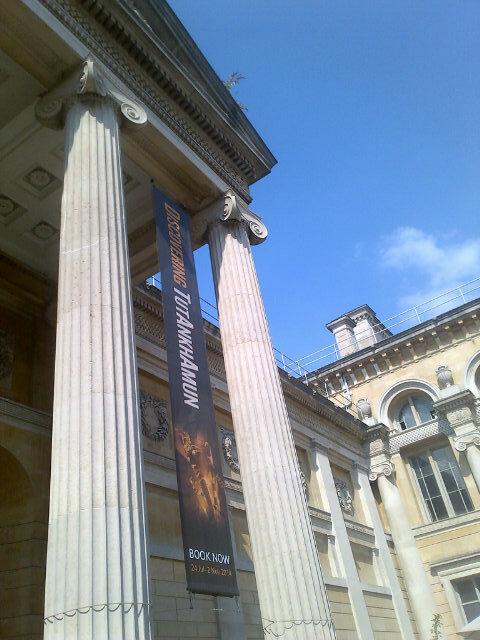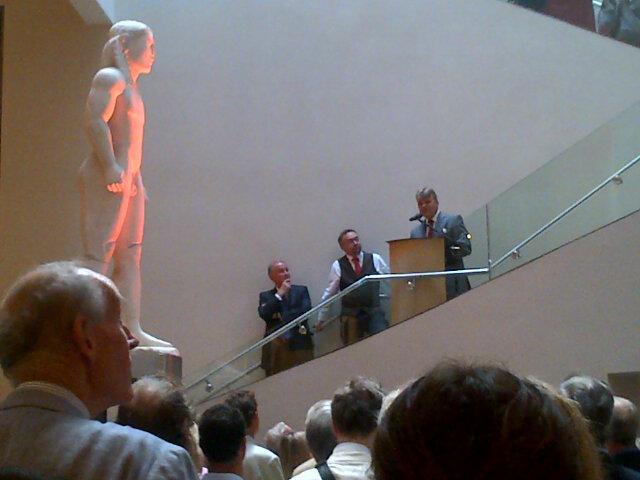I spent a productive few days in London last week in libraries and archives undertaking research for my thesis. While the majority of my time was spent reading, scanning and writing as quickly as I possibly could, true to form I also made time to visit some current exhibitions, all of which had a strong focus on archaeology.

 The first (and admittedly the laziest as I was studying in the British Museum) was their current Room 3 exhibition on the Jericho Skull. While I was aware of this skull in the collection, I'm ashamed to say I was often one of those BM staff who would whizz past its permanent display on the way to the canteen. Room 3 displays - those in the small room immediately to the right as you enter the Museum - are an ideal platform to present the fascinating individual stories of objects which may otherwise be lost in the vast displays upstairs.
The first (and admittedly the laziest as I was studying in the British Museum) was their current Room 3 exhibition on the Jericho Skull. While I was aware of this skull in the collection, I'm ashamed to say I was often one of those BM staff who would whizz past its permanent display on the way to the canteen. Room 3 displays - those in the small room immediately to the right as you enter the Museum - are an ideal platform to present the fascinating individual stories of objects which may otherwise be lost in the vast displays upstairs.
Not only that, they are an opportunity to test more innovative interpretation of objects as a case study for future display. For the case of the Jericho Skull, I especially liked the way that the female excavator of the skull, Kathleen Mary Kenyon (on behalf of the British School of Archaeology in Jerusalem) was given a leading role in the panels to tell the story of the discovery to younger visitors and to ask them questions directly which is a great engagement tool. These panels are also in a bright colour and sit at a lower height for younger visitors. Here, a complex (and sometimes controversial) story of archaeological excavation is presented not only through the Skull itself and the interpretation panels, but also through a 3D print of the skull beneath the plaster which reveals further information about the individual which would not otherwise have been known.

 The exhibition also includes a facial reconstruction of the male individual, based on the 3D print of the skull. While facial reconstructions, particularly of ancient individuals, are inevitably subjective to a degree, it is always fascinating to gaze on the (potential) face of an individual who lived, and died, thousands of years ago, and this reconstruction allows the visitor to do just that.
The exhibition also includes a facial reconstruction of the male individual, based on the 3D print of the skull. While facial reconstructions, particularly of ancient individuals, are inevitably subjective to a degree, it is always fascinating to gaze on the (potential) face of an individual who lived, and died, thousands of years ago, and this reconstruction allows the visitor to do just that. My second exhibition was the Petrie Museum's 'Exporting Egypt', in association with the ongoing collaborative AHRC-funded project between UCL and the Griffith Institute, University of Oxford. This exhibition explores the history of licensed British excavations in Egypt from the 1880s to the 1980s (before the UNESCO Convention came into full force) through a critical lens, presenting the background to the object 'partage' system whereby objects excavated in Egypt were legally exported and distributed to individuals and institutions who sponsored the expeditions. One of the main aims of the 'Artefacts' project is to critically question this practice of object distribution and assess how it impacted on the relationships between archaeology, Egyptology and museums, and this is presented in several ways in this exhibition. One of the most effective is a display on the 'Harageh Treasure', excavated by the British School of Archaeology in Egypt (BSAE) during 1913-14, which was put up for auction by Bonhams in 2014 on behalf of the Archaeological Institute of America’s (AIA) St Louis Chapter.
My second exhibition was the Petrie Museum's 'Exporting Egypt', in association with the ongoing collaborative AHRC-funded project between UCL and the Griffith Institute, University of Oxford. This exhibition explores the history of licensed British excavations in Egypt from the 1880s to the 1980s (before the UNESCO Convention came into full force) through a critical lens, presenting the background to the object 'partage' system whereby objects excavated in Egypt were legally exported and distributed to individuals and institutions who sponsored the expeditions. One of the main aims of the 'Artefacts' project is to critically question this practice of object distribution and assess how it impacted on the relationships between archaeology, Egyptology and museums, and this is presented in several ways in this exhibition. One of the most effective is a display on the 'Harageh Treasure', excavated by the British School of Archaeology in Egypt (BSAE) during 1913-14, which was put up for auction by Bonhams in 2014 on behalf of the Archaeological Institute of America’s (AIA) St Louis Chapter.
 This case questions 'Who Owns Antiquities' - since the 'Harageh Treasure' held precise archaeological provenance through the published accounts of the excavators, this only helped to create a secure biography for the objects. But as they were allotted to the AIA by the BSAE on the grounds that they were a public institution, this sale was contested on ethical grounds since they would no longer be made available to the public and, if sold on the open market, may be transferred to collections which may not provide sufficient safeguards and make them accessible. This case thus challenges the public's perception of how Egyptian objects came to be in UK collections, how auction house sales of objects remain controversial, and in the end to question who actually owns the excavated material in the first place. I especially enjoyed some of the visitor responses to this question, which were written on object labels and hung in the gallery.
This case questions 'Who Owns Antiquities' - since the 'Harageh Treasure' held precise archaeological provenance through the published accounts of the excavators, this only helped to create a secure biography for the objects. But as they were allotted to the AIA by the BSAE on the grounds that they were a public institution, this sale was contested on ethical grounds since they would no longer be made available to the public and, if sold on the open market, may be transferred to collections which may not provide sufficient safeguards and make them accessible. This case thus challenges the public's perception of how Egyptian objects came to be in UK collections, how auction house sales of objects remain controversial, and in the end to question who actually owns the excavated material in the first place. I especially enjoyed some of the visitor responses to this question, which were written on object labels and hung in the gallery.
 My third exhibition during my week in London was the Museum of London Docklands' 'Tunnel: the Archaeology of Crossrail' exhibition, which presented 8000 years of London's history excavated during the construction of the new Elizabeth Line. I'd never visited this site before, so I was looking forward to seeing how it would compare with the Museum of London, one of my favourite galleries in the city. I wasn't disappointed: I made a bee-line for the 'Tunnel' exhibition and just loved the PPE equipment made available to younger visitors, before they even entered the exhibition, to make them feel like they were one of the workmen on the Crossrail project. In fact the whole exhibition was very child-friendly - I visited during Half Term and the gallery was full of fascinated young visitors with their magnifying glasses (made available throughout the exhibition) and asking their parents lots of interesting questions.
My third exhibition during my week in London was the Museum of London Docklands' 'Tunnel: the Archaeology of Crossrail' exhibition, which presented 8000 years of London's history excavated during the construction of the new Elizabeth Line. I'd never visited this site before, so I was looking forward to seeing how it would compare with the Museum of London, one of my favourite galleries in the city. I wasn't disappointed: I made a bee-line for the 'Tunnel' exhibition and just loved the PPE equipment made available to younger visitors, before they even entered the exhibition, to make them feel like they were one of the workmen on the Crossrail project. In fact the whole exhibition was very child-friendly - I visited during Half Term and the gallery was full of fascinated young visitors with their magnifying glasses (made available throughout the exhibition) and asking their parents lots of interesting questions.

 It is truly the most effective interpretation of archaeological work that I've ever seen in a museum exhibition: from the clipboards with completed context sheets alongside associated objects and human remains, to the display on stratigraphy and video presentations from archaeologists and post-excavation researchers presenting their work to the visitors, the scientific basis for the archaeological excavations was projected loud and clear. This message didn't detract from the exhibition design however, which was eye-catching, sleek and clear to follow as the story made its way along the length of the tunnel excavations.
It is truly the most effective interpretation of archaeological work that I've ever seen in a museum exhibition: from the clipboards with completed context sheets alongside associated objects and human remains, to the display on stratigraphy and video presentations from archaeologists and post-excavation researchers presenting their work to the visitors, the scientific basis for the archaeological excavations was projected loud and clear. This message didn't detract from the exhibition design however, which was eye-catching, sleek and clear to follow as the story made its way along the length of the tunnel excavations.
While I used my Museums Association membership card to enter other exhibitions that week (including Undressed at the V&A), I have chosen to focus on my visits to these three free-to-enter exhibitions, to highlight how much can be done for free in London and hopefully also show how much can be gained from a little further exploration in the city.




















